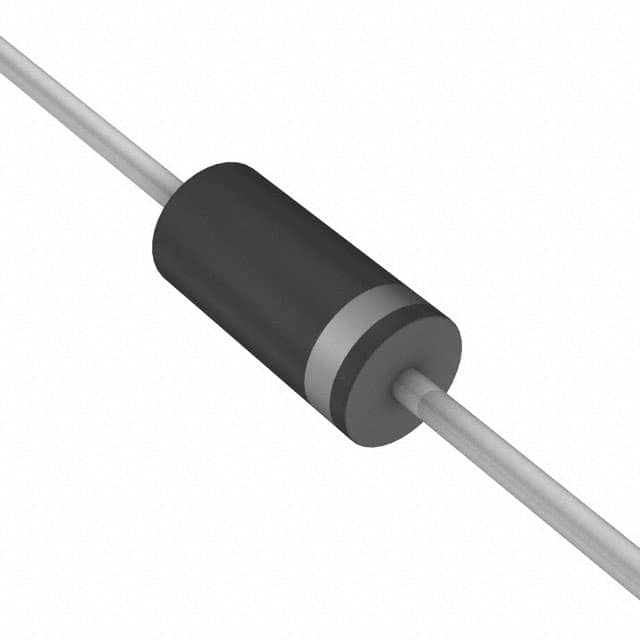SA20CA B0G Product Overview
Introduction
SA20CA B0G is a semiconductor product belonging to the category of transient voltage suppressors (TVS). This device is designed to protect sensitive electronic components from voltage transients induced by lightning, electrostatic discharge (ESD), and other transient voltage events. The following entry provides an in-depth overview of the SA20CA B0G, including its basic information, specifications, pin configuration, functional features, advantages and disadvantages, working principles, application field plans, and alternative models.
Basic Information Overview
- Category: Transient Voltage Suppressors (TVS)
- Use: Protection against voltage transients induced by lightning, ESD, and other transient voltage events
- Characteristics: Fast response time, low clamping voltage, high surge current capability
- Package: DO-204AC (DO-15)
- Essence: Silicon Avalanche Diode
- Packaging/Quantity: Tape & Reel, 500 units per reel
Specifications
- Peak Pulse Power: 1500W
- Breakdown Voltage: 17.8V
- Clamping Voltage: 29.2V
- Maximum Reverse Leakage Current: 1µA
- Operating Temperature Range: -55°C to +175°C
Detailed Pin Configuration
The SA20CA B0G features a standard DO-15 package with two leads. The pin configuration is as follows: - Pin 1: Anode - Pin 2: Cathode
Functional Features
- Fast response time
- Low clamping voltage
- High surge current capability
- RoHS compliant
Advantages and Disadvantages
Advantages
- Effective protection against voltage transients
- Fast response time ensures minimal damage to protected components
- RoHS compliance for environmental sustainability
Disadvantages
- Limited breakdown voltage range compared to some alternative models
- Relatively higher clamping voltage under certain conditions
Working Principles
The SA20CA B0G operates based on the principle of avalanche breakdown. When a transient voltage event occurs, the diode rapidly switches into its low-impedance state, diverting the excess current away from the protected circuitry. This action effectively limits the voltage across the protected components, safeguarding them from damage.
Detailed Application Field Plans
The SA20CA B0G is widely used in various applications requiring protection against voltage transients, including: - Telecommunication equipment - Industrial control systems - Automotive electronics - Consumer electronics - Power supplies
Detailed and Complete Alternative Models
For users seeking alternatives to the SA20CA B0G, the following models can be considered: - SA5.0CA: Lower breakdown voltage, suitable for low-voltage applications - SA24CA: Higher breakdown voltage, ideal for high-voltage applications - P6KE15CA: Similar characteristics with a different package type
In conclusion, the SA20CA B0G offers effective transient voltage suppression for a wide range of applications, with its fast response time and high surge current capability making it a reliable choice for protecting sensitive electronic components.
Word count: 498 words
10个与SA20CA B0G在技术解决方案中的应用相关的常见问题及解答
What is SA20CA B0G?
- SA20CA B0G is a high-performance ceramic material known for its excellent thermal conductivity and electrical insulation properties.
What are the key applications of SA20CA B0G?
- SA20CA B0G is commonly used in technical solutions such as heat sinks, electronic substrates, power modules, and LED packages.
How does SA20CA B0G compare to other materials in terms of thermal conductivity?
- SA20CA B0G exhibits superior thermal conductivity compared to traditional materials like aluminum oxide or alumina.
Is SA20CA B0G suitable for high-temperature environments?
- Yes, SA20CA B0G is designed to withstand high temperatures, making it ideal for applications in demanding thermal conditions.
Can SA20CA B0G be customized for specific technical requirements?
- Yes, SA20CA B0G can be tailored to meet specific dimensional and performance requirements for various technical solutions.
What are the advantages of using SA20CA B0G in power module designs?
- SA20CA B0G offers enhanced thermal management and electrical insulation, contributing to improved reliability and performance of power modules.
Does SA20CA B0G require any special handling during manufacturing processes?
- SA20CA B0G may require specialized machining techniques due to its hardness and brittleness, but it can be processed using standard ceramic fabrication methods.
Are there any limitations or considerations when using SA20CA B0G in electronic substrates?
- While SA20CA B0G provides excellent electrical insulation, designers should consider its coefficient of thermal expansion to ensure compatibility with other components.
What testing standards are typically used to evaluate the performance of SA20CA B0G in technical solutions?
- Common testing standards include thermal conductivity measurements, dielectric strength testing, and thermal cycling tests to assess the reliability of SA20CA B0G.
Can SA20CA B0G be integrated into existing technical solutions without major design modifications?
- In many cases, SA20CA B0G can be seamlessly integrated into existing designs with minimal adjustments, leveraging its unique properties to enhance overall performance.


